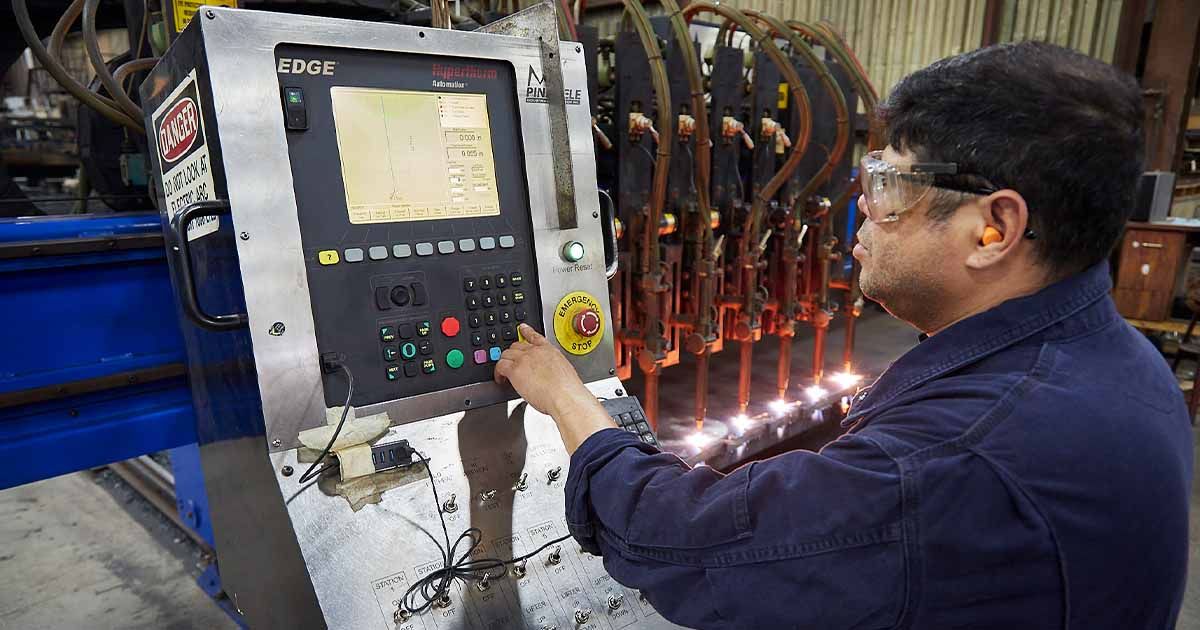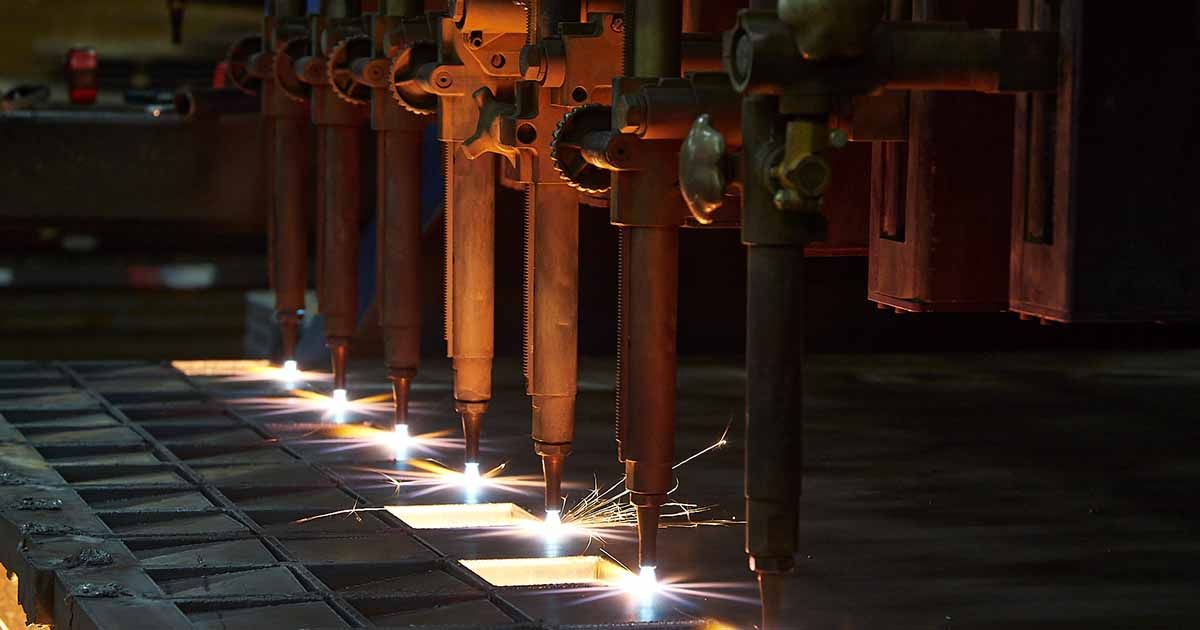
We collect basic website visitor information on this website and store it in cookies. We also utilize Google Analytics to track page view information to assist us in improving our website.

Flame cutting is indispensable in sectors like shipbuilding and construction, where precision and reliability in metal processing are essential. At Amber Steel, we recognize the uniqueness of each project and the importance of selecting the appropriate cutting method for its success.
In this blog post, we’ll explore the versatility of flame cutting, a technique renowned for its proficiency with thick and heavy materials, particularly carbon steel. Our goal is to provide you with the knowledge necessary to make informed choices for your industrial projects.
As experts in flame cutting, we at Amber Steel are committed to delivering unparalleled services across various industries. Our expertise spans across laser, plasma, and flame cutting. Known as a "total source" provider, we are dedicated to producing high-quality steel products. We achieve this through the strategic use of the right production techniques, ensuring the perfect match for each product. Our ongoing investments in equipment and technology afford our clients a range of production alternatives, tailored to meet exact product specifications and tolerances.
For those keen to delve deeper into the world of steel cutting, or if you have a specific project that could benefit from our expertise, we encourage you to reach out. Our team is just an email or phone call away, ready to assist with your needs and answer any queries you might have.
Flame cutting is a powerful and precise method for slicing through thick metals, particularly mild steel. This thermal process is a sophisticated interplay between intense heat and metal.
Here's how it works: an intense oxy-fuel gas flame, powered by acetylene, propane, or natural gas, brings the metal to its ignition temperature. At this critical juncture, a burst of oxygen is introduced, effectively melting the excess material to produce a clean and precise cut.
The key components of flame cutting are:
Cutting Torch: The primary tool in flame cutting, this directs the oxy-fuel gas flame precisely onto the metal.
Fuel Gas Source: Options include acetylene, propane, or natural gas, each fueling the flame in its unique way.
Oxygen Source: This is crucial for removing the molten metal, playing a central role in achieving that perfect cut.
Cutting Table: A robust platform, it supports the metal during the cutting process.
Safety Gear: Given the high-intensity nature of flame cutting, appropriate protective gear is non-negotiable for the safety of operators.
Each component plays a vital role, ensuring the flame cutting process is not just effective, but also safe and efficient.
Flame cutting stands out in the industrial world for its distinct set of benefits, making it a preferred method for a variety of applications. Here’s why:
Mastery in Handling Thick Metals: Flame cutting is the go-to technique for cutting through heavy metal with ease. It’s particularly adept at slicing through steel up to an impressive 270mm thickness in a single pass, showcasing its robust capability.
Cost-Effectiveness: In an industry often challenged by rising costs, flame cutting services offer a more budget-friendly solution. It primarily uses gas and oxygen, making it an economically sound choice for many projects.
Versatility in Application: Flame cutting isn’t limited to a single industry. Its utility extends from manufacturing to aerospace, demonstrating its adaptability to various metal-cutting requirements.
Simplicity of Equipment: Its ease of operation and accessibility make it a practical choice for many.
Customization and Scalability: Flame cutting services are as versatile as they are scalable. Whether you’re working on a unique, one-time project or ramping up for larger-scale production, this method offers the flexibility to meet diverse requirements while maintaining precision and quality.
It’s important to recognize that flame cutting, like any technique, has its limitations. It’s not the best fit for highly detailed, precision cuts, as the heat involved in the process can cause warping or distortion. However, for projects involving thicker materials or larger profiles where ultra-precision is not the top priority, or can be fine-tuned post-cutting, flame cutting truly excels.
Heavy industries need a cutting solution as robust as their projects. Flame cutting is that solution. It's a powerhouse in sectors like shipbuilding and construction, where dealing with steel isn't just a task, it's the task.
Consider shipbuilding. Here, flame cutting plays a crucial role. It's how massive steel plates and sections are precisely shaped to build everything from the bow to the stern of giant ships.
In construction, think of skyscrapers and bridges. Flame cutting is front and center here, shaping the beams and girders that make up these structures. In this world of heavy steel, flame cutting is a go-to for its ability to handle tough jobs.
Where typical metal cutting methods falter, flame cutting steps in. It's all about handling the big stuff – thick steel plates that others find too challenging. This is where flame cutting shines, using intense heat to cut through even the thickest steel, especially carbon steel, known for its strength and resilience.
Imagine a scenario with really thick metal. Flame cutting is like the hero coming to the rescue. It heats metals to extreme temperatures, ideal for those hefty steel plates that need a firm hand.
In the domain of metal thickness, flame cutting is king, effortlessly dealing with a wide range of materials.
Metal fabrication isn't a one-size-fits-all business. Projects often require a personalized approach, and this is where flame cutting excels. It's versatile, adjusting to different sizes and thicknesses of metal with ease.
Companies like Rode Welding and Ruff Manufacturing are experts in flame cutting. They're all about precision, cutting large steel plates to specific requirements. Whether it's creating detailed shapes, handling unique sizes, or meeting tight tolerances, flame cutting is their tool of choice.
Flame cutting's flexibility makes it ideal for projects needing a custom touch. It's about making your vision a reality, with each cut tailored to your needs.
Metal cutting isn't just about slicing through material; it's about making smart choices. The right method can make a job efficient, cost-effective, and high-quality.
So, what should guide this decision? Think about the metal's type and thickness, the precision you need, the speed of the job, and, of course, the cost.

Metals are a diverse bunch. They differ in thickness, hardness, conductivity, and more. These traits steer you towards the best cutting method. Softer metals like aluminum? Hand tools or abrasive methods work well. Tough customers like titanium? They often call for something heftier, like plasma or laser cutting.
Thicker metal demands a robust approach. Think flame or plasma cutting. For the thinner varieties, hand cutting or waterjet methods are often sufficient.
How precise do you need to be? Aerospace or medical fields demand high accuracy and minimal distortion. Construction? It can handle a bit more give-and-take.
Time is money. Need a fast turnaround? Plasma cutting might be your go-to. If it's a low-volume or custom job, slower methods like manual or laser cutting could be more up your alley.
Look at the whole picture: equipment, maintenance, labor. Some methods might cost more upfront but save you money in the long run. Others are cheaper to start but might need more upkeep.
Getting advice from seasoned pros is a smart move. They can weigh in on your specific needs, budget, and desired outcomes, offering insights into the latest cutting tech and techniques.
Each method, be it flame, plasma, or laser cutting, has its pros and cons. Flame cutting is great for thick, tough metals but can cause thinner metals to warp. Plasma cutting is quicker and more precise for thicker metals, with less heat to boot. Laser cutting is top-notch for accuracy and efficiency, though it might dent your wallet more at the outset. Your choice should match your project's unique needs and limits.
Flame cutting is a robust and formidable technique in heavy industries like shipbuilding and construction. It's not just about slicing through metal; it's about precision and understanding the material. Imagine shipbuilders shaping massive steel plates, the very foundations of mighty vessels. Consider the construction industry, where steel beams and girders, shaped by flame cutting, form the skeleton of skyscrapers and bridges.
Yet, it's crucial to recognize that flame cutting isn't a catch-all solution. It demands expertise, a discerning eye for when and where it's most effective. It's not as simple as directing a flame at any metal and expecting results. Every material reacts differently, and that's where our expertise comes into play.
At Amber Steel, we approach each project with a consultative, client-centered mindset. We don't just offer a service; we deliver a tailored solution. Our goal is to align each project with the most suitable cutting method, transforming success from a mere possibility into a certainty.
Flame cutting is a vital part of our repertoire, but it's not the only one. We recognize the varied needs of the industrial world, hence our diverse range of cutting technologies. Whether your project is large or small, simple or complex, our team is equipped to provide expert guidance and superior cutting solutions.
We pride ourselves on being a "total source" service in laser, plasma, and flame cutting, consistently delivering quality steel products. This commitment to quality is realized by selecting the appropriate production technique for each product. Our continuous investment in equipment and technology affords us the flexibility to offer multiple production alternatives, ensuring precise adherence to product specifications and tolerances.
Interested in exploring more about steel cutting, or have a specific project in mind? Don't hesitate to reach out. At Amber Steel, we're always just an email or phone call away, ready to assist with your cutting needs and queries.